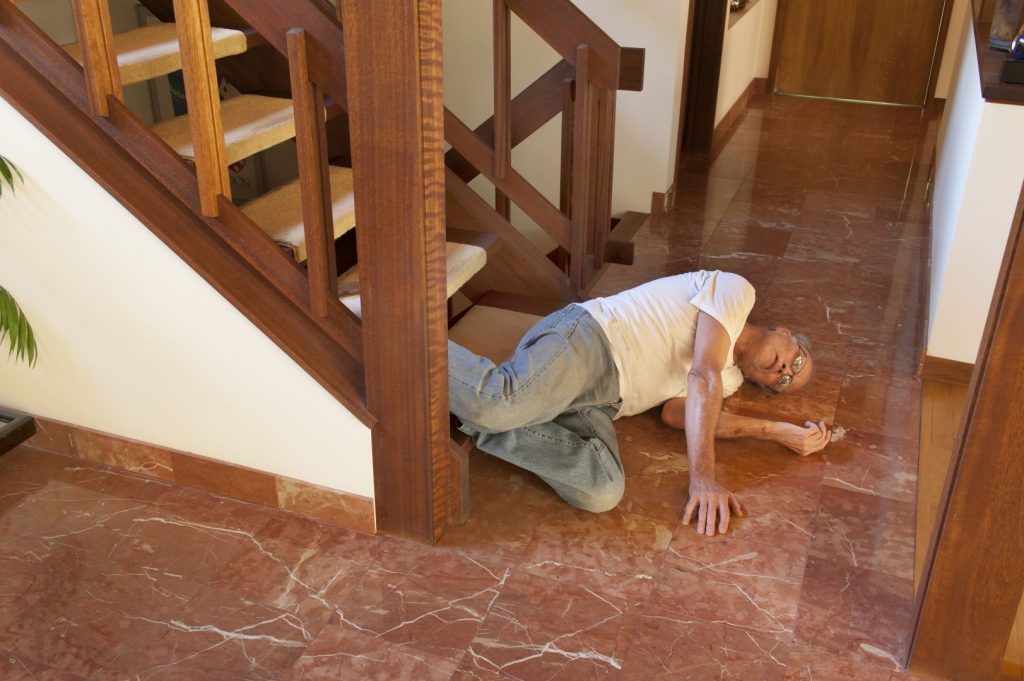
Falls can happen in so many ways in our homes and can be potentially very dangerous so we have to be extremely diligent in how we design and furnish our client’s homes
Falling accidentally and unexpectedly, at most any age, especially when we fall forward can be uncomfortable and potentially quite hazardous. It can be fatal in extreme cases. There are times, particularly as children when we fall intentionally or accept it such as during a game or activity (football, wrestling, baseball, karate, track and field, tag, red rover, and other such neighborhood games or organized sporting activities). However, as we get older, and no games are involved, falling is not fun in any way.
Sometimes, falls can be minimized as we trip or slip and catch ourselves before totally falling, or we are able to adjust our balance and break our fall somewhat just before we impact the floor, ground, or other surface we contact.
Still, the reason falling forward is dangerous is that we can hit our heads, potentially resulting in a TBI (traumatic brain injury), or we could injure our arm, elbow, wrist, hand, knee, foot, ankle, or hip as we fall and try to lessen our impact or they get bent under us at an awkward, unnatural angle.. We also could damage our face, break our nose, hurt or teeth, or injure our eyes.
The more we try to avoid hurting a certain body part, such as protecting our hands, fingers, or knees, the more likely we are to cause injury to ourselves. The main thing to remember about a fall is that it happens extremely quickly. From the initial loss of balance until being on the ground can be just a second or two. There just is so little time to react or avoid impacting anything dangerous as we fall and impact a generally hard, immovable object or surface.
While falling forward is dangerous, falling backward or to the side is worse. At least while we are falling forward we have a chance, albeit brief and in a state of panic, to see what it in front of us that we might hit and attempt to adjust ourselves to miss something that might cause even greater injury, This often leads to even greater consequences, however. Sometime when we just fall and attempt to roll out of the impact to dissipate the energy – when we are able to do this – we come out better than trying to avoid the impact and potentially making things worse.
When we fall backwards, we risk doing serious damage to our backs and anything we use to try to prevent the impact such as our hands and arms. We can’t generally see what is behind us that we are falling on so the potential for more serious injury is there. The same is true when falling to the side when we can’t always pick our landing spots because of the tight confines of where the slip or trip occurs or objects that are in the way of our impact that we can’t avoid due our angle of falling – much like a tree when it comes down.
Unfortunately, falling is part of life. Any of us who have watched babies learning to walk or just trying to pull themselves into a standing position, using an end table or chair (and sometimes a cooperative large family dog) see how often this happens (the falling) and how basically unperplexed they are by this type of situation. They fall repeatedly on their bottom (sitting straight down rather hard and quick) or over to one side. The nice thing is that they usually are wearing diapers which offer some padding and they are close to the ground to start with so the distance of the fall is minimal. Additionally, this process is repeated endless times until they are able to stand on their own and take enough steps to get to a place where they can hold on or rest.
A major difference between the very young and people as they get older is that young people are quite flexible. Whereas they can fall and absorb the impact, an older person’s skeletal structure, bone health, and musculature tends to be more rigid or less responsive to the types of demands a fall or sudden impact would cause. Another is that the younger we are, the more we accept falling as something that happens – even while learning to ride a bike, rollerblade, or skateboard – and not a traumatic or scary event that can often lead to injury. When we slip on the ice or a wet shower or bathroom floor, we know how scary this can be because we know that the likelihood of us going down is high and the prognosis for us just bouncing us like a small child is small.
Falls are not good for us or for our long-term health, and this is why there are many programs emphasizing safety on and around the home.
